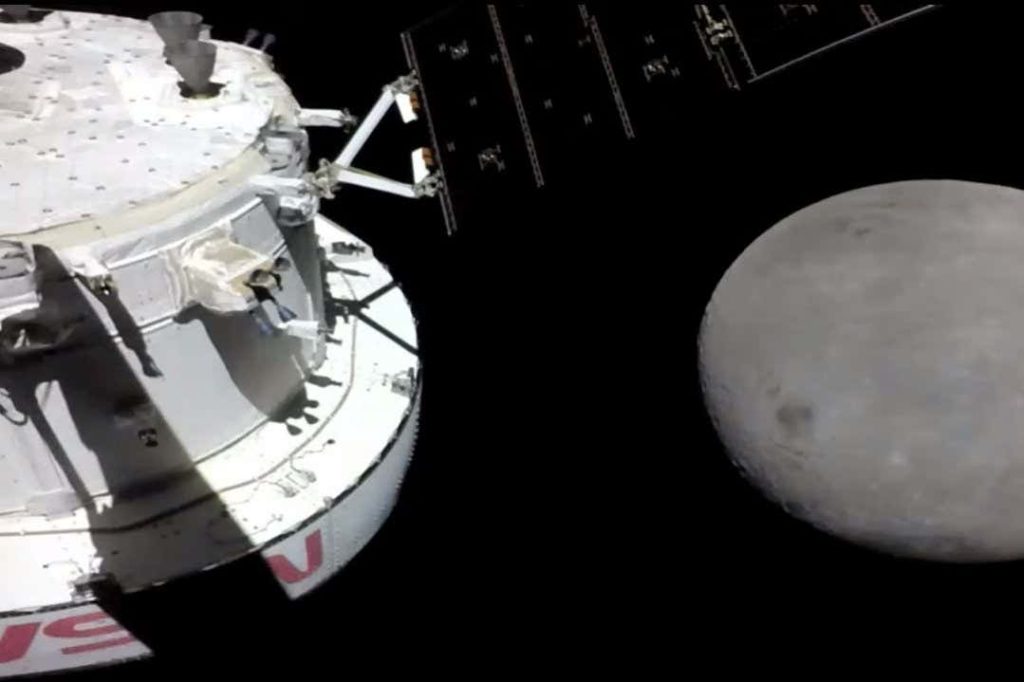NASA’s Artemis I mission has made a close approach to the moon, flying within 130 kilometres above the farside of the lunar surface on 21 November.
The Orion capsule blasted off on top of the enormous Space Launch System (SLS) rocket, the most powerful ever launched, on 16 November. After years of delays and several missed launch opportunities this year thwarted by hydrogen leaks, technical issues and, most recently, a hurricane that SLS weathered on the launchpad at Cape Canaveral in Florida, the lift-off went astonishingly smoothly.
“It was surprising to me that it went without a hitch,” says space analyst Laura Forczyk. “I mean, there were small hitches, but it didn’t explode!” The biggest of those hitches was a set of loose bolts that a team was sent out to the launchpad shortly before launch to tighten – it is extraordinarily rare to see anyone working on rocket hardware so close to lift-off.
Advertisment
Orion is expected to enter orbit around the moon on 25 November. Then, after six days in orbit, it has got to come back – a part of the mission that is just as crucial as the launch itself. It is expected to return to Earth on 11 December.
“Bringing Orion back is going to be as big a challenge as getting off the Earth,” NASA associate administrator Thomas Zurbuchen told New Scientist. “The risks just add up… The mission is only over once Orion is down safely here.” Only then can it be considered safe enough to put humans aboard, which is the goal of the Artemis II mission, currently planned for 2024.
For that mission, NASA will have to be even more careful. “Humans are needy creatures,” says Emily Judd at NASA’s Langley Research Center in Virginia. “We have to have the oxygen to breathe, we need food, all of the life-support systems that are required – part of Artemis I is testing out those systems, making sure that everything is ready for the crew when they go up on Artemis II.”
While Artemis I’s main purpose is to test the SLS and Orion spacecraft ahead of Artemis II, which will see a crewed Orion perform a lunar flyby, there are some other scientific goals as well. SLS carried 10 cubesats, which are small satellites weighing only about 11 kilograms each, and released them into space hours after the launch.
Four of the cubesats are designed to study the moon, including a Japanese experiment called Omotenashi, which is intended to perform a soft landing on the moon’s surface. This would make Japan only the fourth nation to do so, and with the smallest lunar lander ever. However, Omotenashi appears to be tumbling in space, which might prevent it from landing.
Artemis I approaching the moon
NASA
Three of the cubesats are intended to study radiation in space. Another, called NEA Scout, will fly via solar sail to a nearby asteroid, while the remaining two are technology demonstrations for improved methods of deep-space propulsion. According to a NASA press conference on 18 November, five of the 10 cubesats are currently functioning as expected, while the other five are experiencing either technical issues or are unable to communicate with their operators on Earth.
Artemis I is building to the Artemis III mission, which is intended to take astronauts to the moon’s surface for the first time since Apollo 17 in 1972 – and inform future scientific study. “We have barely touched the surface of what we can learn – yes, about the moon, but also about Earth and about how we can survive on Mars,” says Forczyk. “The moon is the stepping stone to the solar system.”
Sign up to our free Launchpad newsletter for a voyage across the galaxy and beyond, every Friday
Topics:

